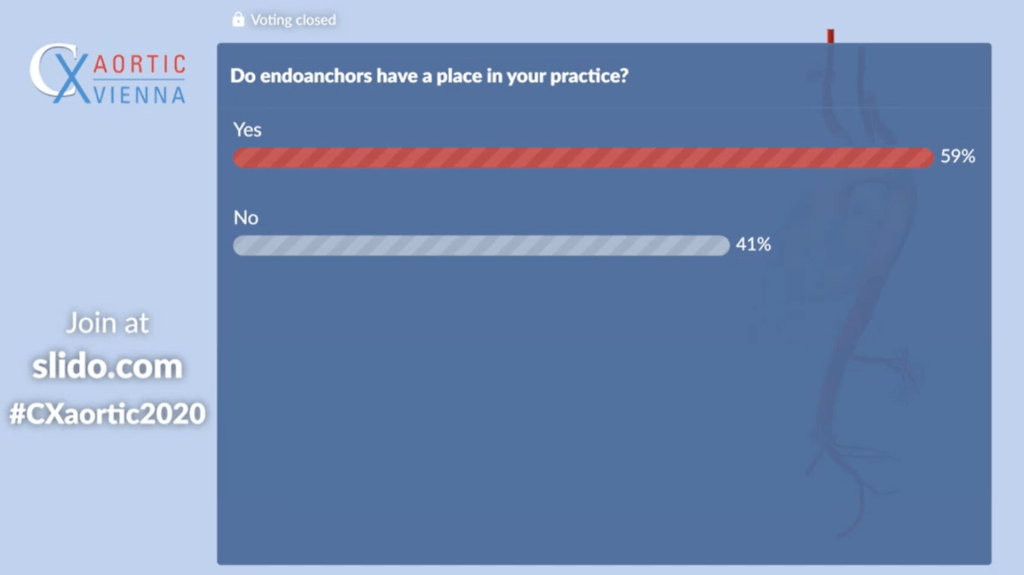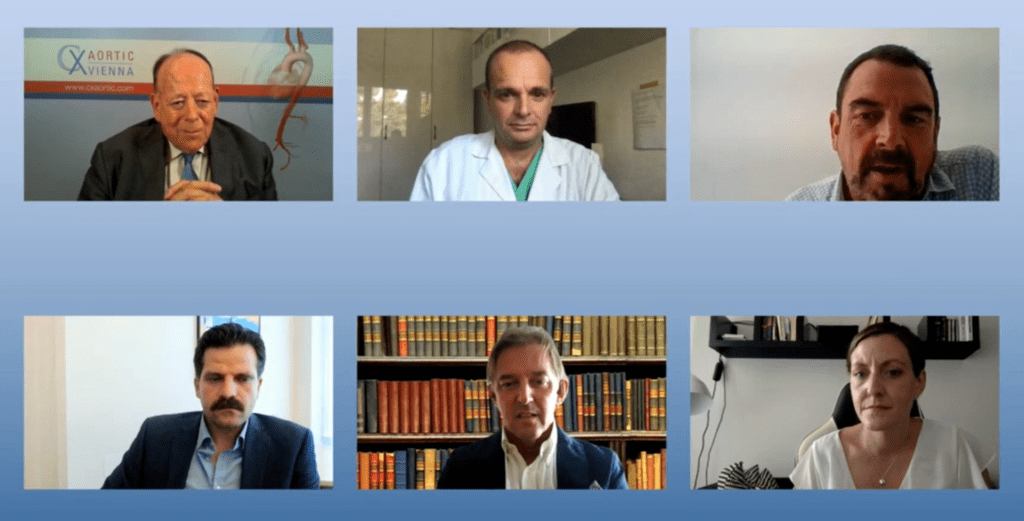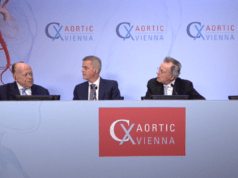
Expert speakers gathered online on the last day of CX Aortic Vienna to discuss juxtarenal issues in the challenging abdominal aneurysm neck, covering topics including the use of endoanchors.
This session, and all other sessions from day four of CX Aortic Vienna, are available to view on demand. Click here to register and access the recording.
Afshin Assadian (Vienna, Austria) opened the session with a presentation favourably comparing a new, experimental methodology for planning a fenestrated endovascular aortic aneurysm repair (FEVAR) to the standard approach. The results of a prospective, multicentre European study investigating numerical simulation as a way of preparing for FEVAR showed it was as precise as the conventional planning method, he shared, and much more rapid, as it takes 2–3 days, compared to 4–5 weeks with the conventional method.
Speaking on behalf of the United States Aortic Research Consortium, Andres Schanzer (Worcester, USA) next presented some technical tips on how to perform fenestrated/ branched EVAR (F/BEVAR) to treat failed EVARs. While he acknowledged that conversion to FEVAR is associated with technical challenges, Schanzer shared positive results obtained from the analysis of prospectively collected data from six US sites.
The results led Schanzer to conclude that F/BEVAR is safe and effective in patients with prior failed EVAR, with nearly identical outcomes as compared to patients without prior EVAR. “Differences in procedural metrics indicate higher level of technical challenge when performing F/BEVAR in patients with prior failed EVAR. F/BEVAR, at high volume centres, is a viable option for the treatment of EVAR failure that compares favourably to historical reports of open conversion,” he closed.
 Majority of CX Aortic Vienna audience have a place for endoanchors in their practice
Majority of CX Aortic Vienna audience have a place for endoanchors in their practice
Mauro Gargiulo (Bologna, Italy) presented delegates an edited case, demonstrating the use of endoanchors to enhance proximal sealing in EVAR. The 76-year-old abdominal aortic aneurysm patient had a “short, severe” neck, and no problem with iliac access. Gargiulo talked his audience through the specifics of the case, describing how the operators stabilised the endograft with the Heli-FX EndoAnchor system (Medtronic).
In response to the polling question “Do endoanchors have a place in your practice?” 59% of the audience answered “yes”.

Next, Kyriakos Oikonomou (Regensburg, Germany) discussed the latest evidence from the ANCHOR registry, which showed that endoanchors can facilitate and maintain successful standard EVAR for abdominal aortic aneurysms with challenging proximal necks. “The ANCHOR primary study arm with hostile necks shows favourable four-year outcomes, with low mortality rates and a high rate [62%] of sac regression.”
These positive data mean interventionalists “can safely and effectively treat a number of patients with hostile anatomies without resorting to more complex endovascular strategies,” he concluded.
Describing renal rescue after (F)EVAR, Jos van den Berg (Lugano, Switzerland) told audience members that renal artery occlusion was “very uncommon”, but that when this occurs in an abdominal aortic aneurysm patient, it is a “severe complication”. Listing the possible treatment options, van den Berg described the historical pull-down technique, chimney EVAR (chEVAR), stenting, in situ fenestration, hepato-spleno-renal byass, and renal auto-transplantation.
“Renal rescue after FEVAR is feasible, even after longer standing occlusion,” he concluded. “In those cases, revascularisation is only useful when distal perfusion is still preserved.”
Miriam Kliewer (Vienna, Austria) closed the session with a presentation that argued that exclusion of complex aortic aneurysms with chimney endovascular aneurysm repair (chEVAR) “is applicable in a minority of patients successfully treated with fenestrated endografts”.
Kliewer and colleagues set out to assess the general applicability of the CE-approved chimney procedure in patients already treated with FEVAR. They found that, compared to FEVAR, chEVAR is cheaper, demands fewer technical skills, and is readily available, as it can be performed using off-the-shelf devices. Out of 100 patients, 19 could have been treated with 35 chEVAR devices, she reported.
In elective EVAR, however, she noted that a broad population of patients “seem anatomically not suitable for chEVAR”. Therefore, she told the CX Aortic Vienna audience: “We need to work on faster delivery of custom-made devices, and lower the costs. Of course,” she concluded, “the top priority has to be the best option for the patient, with a system the surgeon is most familiar with.”












